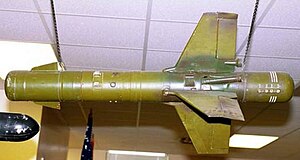9M17 Fleyta
This article includes a list of general references, but it lacks sufficient corresponding inline citations. (November 2014) |
| 3M11 / 9M17 AT-2 Swatter | |
|---|---|
 AT-2C Swatter | |
| Type | Anti-tank missile |
| Place of origin | Soviet Union |
| Service history | |
| In service | 1964-present |
| Production history | |
| Designer | Nudelman OKB-16 |
| Specifications | |
| Mass | 27 kilograms (60 lb) |
| Length | 116 cm (46 in) |
| Diameter | 148 mm (5.8 in) |
| Wingspan | 68 cm (27 in) |
| Warhead | HEAT |
| Warhead weight | 5.4 kg (12 lb) |
| Engine | Solid fuel rocket |
Operational range | 0.5 to 2.5 kilometres (0.31 to 1.55 mi) |
| Maximum speed | 160 m/s (360 mph) |
Guidance system | Radio command |
Steering system | MCLOS |
Launch platform | Mi-4, Mi-8, Mi-24, Mi-25, BRDM-1, BRDM-2 |
The AT-2 Swatter is the NATO reporting name for the 3M11 Fleyta (flute) SACLOS radio command anti-tank missile of the Soviet Union.
Development
The missile was developed by the Nudelman OKB-16 design bureau. It was developed at about the same time as the AT-1 Snapper as a heavy ATGM for use on both ground launchers and helicopters. It addressed some of the problems of the AT-1; it was much faster, and had slightly longer range. These improvements were achieved by sending commands via a radio link instead of a trailing guidance wire, which allowed the missile to travel faster. However, it did make it vulnerable to jamming. The missile system was shown to Soviet premier Nikita Khrushchev in September 1964, and accepted for service shortly afterwards.
History

The AT-2 was the first Soviet ATGM to be deployed from helicopters. Small numbers were fitted to the Mi-4AV. The missile was deployed on the Mi-8 Hip as well as the Mi-24 and Mi-25 'Hind' series of helicopters. It was also deployed on the BRDM-1 and BRDM-2 infantry fighting vehicles.
The original AT-2A (3M11 Falanga) missile was problematic; one Russian source describes the missile as "notable for its complexity and low reliability". Also, the missile's range was felt to be inadequate. An improved version of the missile was developed: the AT-2B (9M17 Skorpion). Externally, the missiles are very similar, however the AT-2B range is increased to 3.5 km. The standard production version was the 9M17M Skorpion-M, which entered service in 1968.
The next development was to integrate SACLOS guidance, resulting in the AT-2 Swatter-C or 9M17P Skorpion-P. It entered service in 1969. A product improved version the 9M17MP was developed that had an improved engine and signal lamp.
The missile has been used extensively in the following wars on the Mi-24 platform.
It was replaced in Soviet service by the 9K114 Shturm ATGM.
General characteristics (AT-2 Swatter A)

- Length: 1,160 mm
- Wingspan: 680 mm
- Diameter: 148 mm
- Launch weight: 27.0 kg
- Speed: 150–170 m/s
- Range: 500 m - 2.5 km
- Time to maximum range: 17 seconds
- Guidance: Radio command MCLOS
- Warhead: 5.4 kg HEAT 500 mm vs RHA;maximum 650 mm vs RHA for improved variant.[1]
Models
- AT-2A Swatter A MCLOS
- 3M11 / 9M11
- AT-2B Swatter B Range increased to 3.5 km.
- AT-2C Swatter C SACLOS Falanga-PV (Fleyta) 9K8. Launch weight 29 kg.
- 9M17P First SACLOS version.
- 9M17MP Improved engine and guidance lamp. Maximum range 4,000 m.
- 9M17N
Operators

Current operators
 Afghanistan
Afghanistan Angola
Angola Bulgaria
Bulgaria Cuba
Cuba Cyprus
Cyprus Egypt
Egypt Hungary
Hungary India
India Libya
Libya North Korea
North Korea Peru
Peru Romania
Romania Syria
Syria Vietnam
Vietnam Yemen
Yemen
Former operators
 Czechoslovakia - passed on to successor states.
Czechoslovakia - passed on to successor states. Czech Republic
Czech Republic East Germany – Used on Mi-24D, and subsequently passed on to the unified German state, and retired soon after.
East Germany – Used on Mi-24D, and subsequently passed on to the unified German state, and retired soon after. Iraq - Destroyed during the 2003 invasion of Iraq.
Iraq - Destroyed during the 2003 invasion of Iraq. Poland - only used on Mi-24D, withdrawn from service.
Poland - only used on Mi-24D, withdrawn from service. Russia - Missiles using as targets for training.
Russia - Missiles using as targets for training. Slovakia
Slovakia Soviet Union - passed on to successor states.
Soviet Union - passed on to successor states.
Sources
- Hull, A.W., Markov, D.R., Zaloga, S.J. (1999). Soviet/Russian Armor and Artillery Design Practices 1945 to Present. Darlington Productions. ISBN 1-892848-01-5.
